Elastic AI agent builder 介绍(四)
本文介绍了如何在Python应用中访问Elastic AI Agent Builder创建的agents。主要内容包括:1) 环境配置,需设置.env文件包含ES_AGENT_URL、ES_API_KEY和AGENT_ID;2) 示例代码展示如何通过A2ACardResolver和A2AAgent类连接并调用agent;3) 支持中英文查询机票价格信息;4) 提供了基于Gradio的Web界面实现
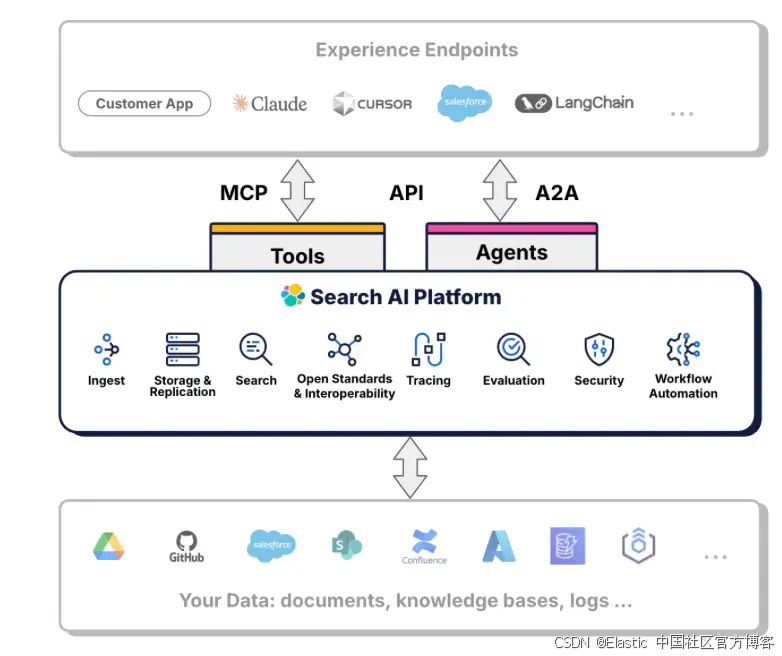
在我之前的文章 “Elastic AI agent builder 介绍(一)”,我详细地介绍了如何在 Kibana 中创建 tools 及 agents。在今天的文章里,我讲详细地介绍如何在 Python 应用里访问这些 agents。我们可以参考文章 “开始使用 Elastic Agent Builder 和 Microsoft Agent Framework”。
安装
我们首先参考文章 “Elastic AI agent builder 介绍(一)” 来进行安装。我们也需要按照这个章节来创建一个叫做 find_the_cheapest_ticket_from_cn_us 的 agent。
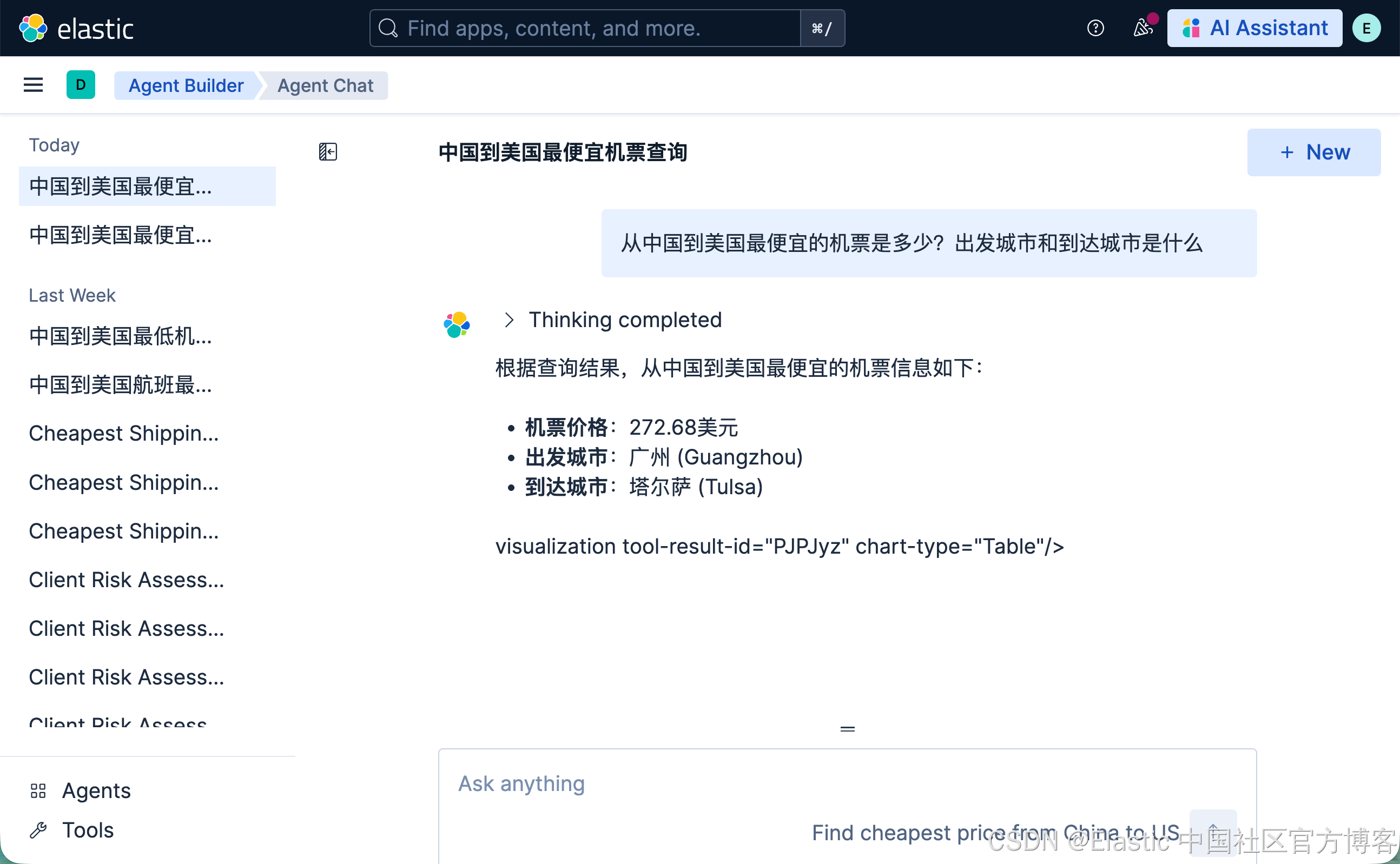
我们可以在 Agents 界面中进行如上的查询。
下载代码
接下来,我们下载已经创建好的代码:
git clone https://github.com/liu-xiao-guo/ai_agent_builder然后我们进入到项目的根目录中,并创建一个叫做 .env 的文件:
.env
ES_AGENT_URL=http://localhost:5601/api/agent_builder/a2a
ES_AGENT_BUILDER_URL=http://localhost:5601/api/agent_builder
ES_API_KEY=WnJwR3RKb0JGQVVCVjdnb29yUkI6RHotbGZBTmJzMDJWUWszbTAtbDVjQQ==
AGENT_ID=find_the_cheapest_ticket_from_cn_us
TOOL_ID=find_cheapest_ticket_from_cn_us我们需要根据自己的配置进行相应的修改。我们可以通过如下的方法来得到你自己的 a2a 地址:

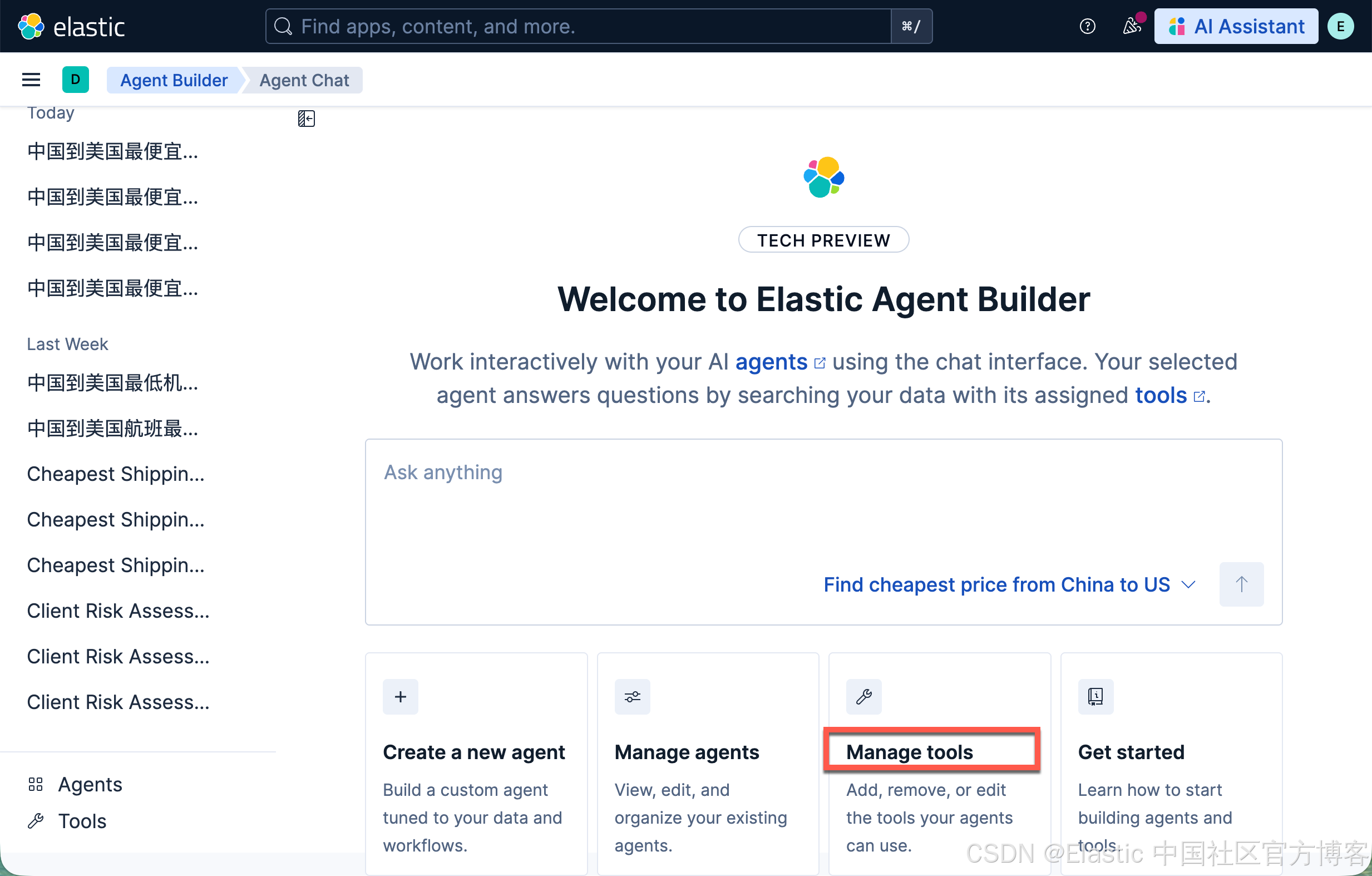
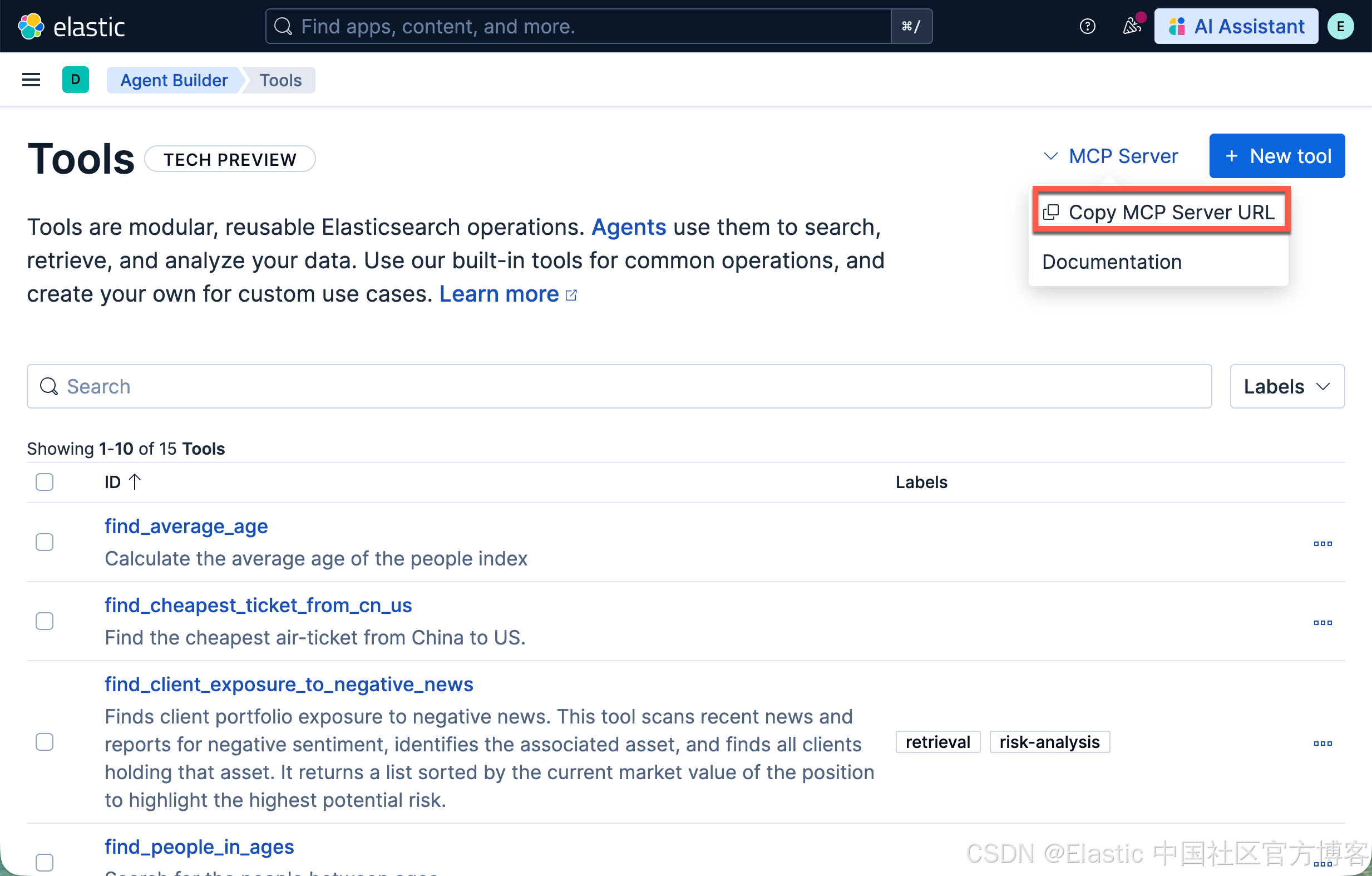
针对我的情况,上面的地址是:
http://localhost:5601/api/agent_builder/mcp很显然,上面的地址是给 MCP 而用的。我们需要把上面的 mcp 换成 a2a,这样它的地址就是:
http://localhost:5601/api/agent_builder/a2a接下来,我们来创建一个用于我们访问 Elasticsearch 的 API key:

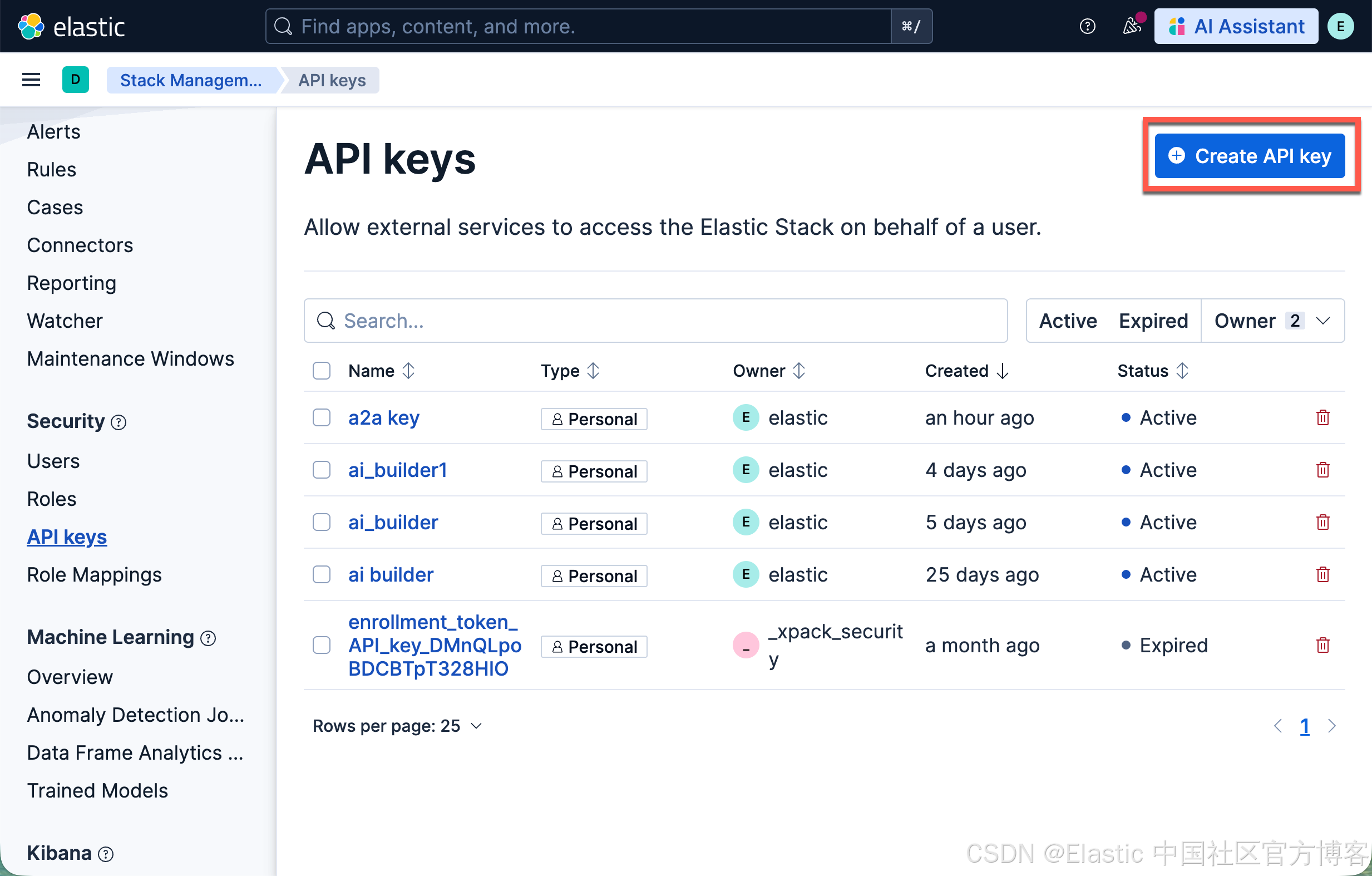
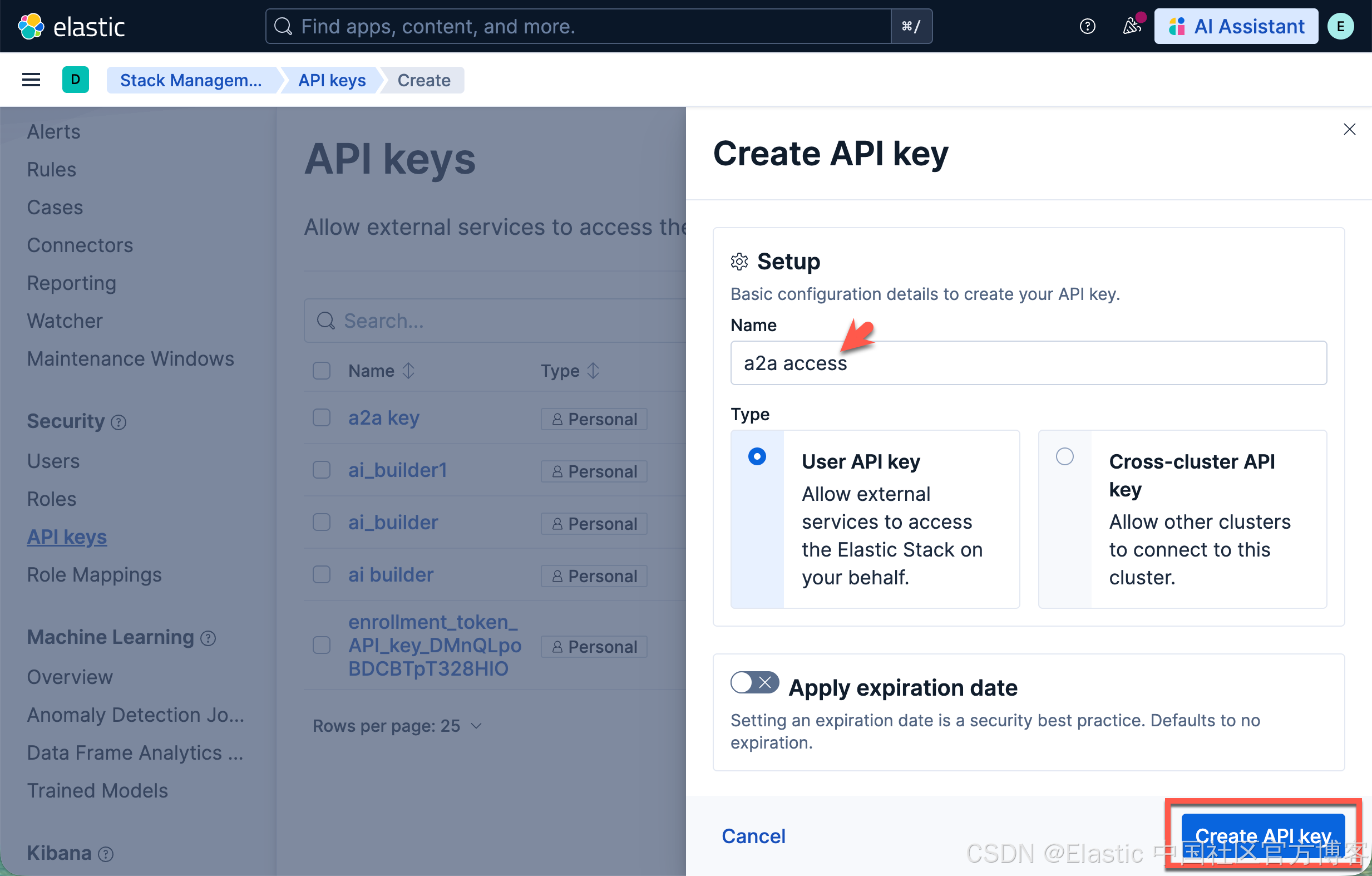

拷贝上面的 key。这样我们就完成了我们的 API key 申请。
另外,我们需要填入我们想要访问的 agent ID,比如上面的 find_the_cheapest_ticket_from_cn_us
接下来,我们需要使用如下的命令来安装所需要的包:
pip install -r requirements.txt 运行代码
我们的代码非常简单:
access_agents.py
import asyncio
from dotenv import load_dotenv
import httpx
import os
from a2a.client import A2ACardResolver
from agent_framework.a2a import A2AAgent
async def main():
load_dotenv()
a2a_agent_host = os.getenv("ES_AGENT_URL")
a2a_agent_key = os.getenv("ES_API_KEY")
agent_id = os.getenv("AGENT_ID")
print(f"Connection to Elastic A2A agent at: {a2a_agent_host}")
custom_headers = {"Authorization": f"ApiKey {a2a_agent_key}"}
async with httpx.AsyncClient(timeout=60.0, headers=custom_headers) as http_client:
# Resolve the A2A Agent Card
resolver = A2ACardResolver(httpx_client=http_client, base_url=a2a_agent_host)
agent_card = await resolver.get_agent_card(
relative_card_path=f"/{agent_id}.json"
)
print(f"Found Agent: {agent_card.name} - {agent_card.description}")
# Use the Agent
agent = A2AAgent(
name=agent_card.name,
description=agent_card.description,
agent_card=agent_card,
url=a2a_agent_host,
http_client=http_client,
)
prompt = input("Enter Greeting >>> ")
print("\nSending message to Elastic A2A agent...")
response = await agent.run(prompt)
print("\nAgent Response:")
for message in response.messages:
print(message.text)
if __name__ == "__main__":
asyncio.run(main())我们运行上面的应用:
python access_agents.py 从中国到美国最便宜的机票是多少?出发城市和到达城市是什么?$ pwd
/Users/liuxg/python/ai_agent_builder
$ ls
README.md access_agents.py requirements.txt
$ python access_agents.py
Connection to Elastic A2A agent at: http://localhost:5601/api/agent_builder/a2a
Found Agent: Find cheapest price from China to US - Find cheapest price from China to US
Enter Greeting >>> 从中国到美国最便宜的机票是多少?出发城市和到达城市是什么?
Sending message to Elastic A2A agent...
Agent Response:
根据查询结果,从中国到美国最便宜的机票信息如下:
- **机票价格**:272.68美元
- **出发城市**:广州 (Guangzhou)
- **到达城市**:塔尔萨 (Tulsa)很显然,我们得到了我们想要的结果。
我们也可以使用英文来进行提问:
What is the cheapest air-ticket price from China to US? What are the origin city and the destination city?$ python access_agents.py
Connection to Elastic A2A agent at: http://localhost:5601/api/agent_builder/a2a
Found Agent: Find cheapest price from China to US - Find cheapest price from China to US
Enter Greeting >>> What is the cheapest air-ticket price from China to US? What are the origin city and the destination city?
Sending message to Elastic A2A agent...
Agent Response:
Based on the flight data, the cheapest air-ticket from China to the US is:
- **Price**: $272.68
- **Origin City**: Guangzhou, China
- **Destination City**: Tulsa, USA如果我们想使用 gradio 来做一个网页,那么我们可以把我们的代码修改为:
access_agents_gradio.py
import asyncio
from dotenv import load_dotenv
import httpx
import os
from a2a.client import A2ACardResolver
from agent_framework.a2a import A2AAgent
import gradio as gr
# ---------- Global variables ----------
a2a_agent_host = None
a2a_agent_key = None
agent_id = None
agent_card = None
custom_headers = None
# ---------- Initialize everything once ----------
async def init_agent():
global a2a_agent_host, a2a_agent_key, agent_id, agent_card, custom_headers
load_dotenv()
a2a_agent_host = os.getenv("ES_AGENT_URL")
a2a_agent_key = os.getenv("ES_API_KEY")
agent_id = os.getenv("AGENT_ID")
print(f"Connecting to Elastic A2A agent: {a2a_agent_host}")
custom_headers = {"Authorization": f"ApiKey {a2a_agent_key}"}
async with httpx.AsyncClient(timeout=60.0, headers=custom_headers) as http_client:
resolver = A2ACardResolver(httpx_client=http_client, base_url=a2a_agent_host)
agent_card = await resolver.get_agent_card(
relative_card_path=f"/{agent_id}.json"
)
print(f"Loaded Agent Card: {agent_card.name} - {agent_card.description}")
# ---------- Function that Gradio will call ----------
async def call_agent(prompt):
async with httpx.AsyncClient(timeout=60.0, headers=custom_headers) as http_client:
agent = A2AAgent(
name=agent_card.name,
description=agent_card.description,
agent_card=agent_card,
url=a2a_agent_host,
http_client=http_client,
)
response = await agent.run(prompt)
return "\n".join([msg.text for msg in response.messages])
# ---------- Gradio wrapper (sync → async) ----------
def gradio_handler(prompt):
return asyncio.run(call_agent(prompt))
# ---------- Launch Gradio UI ----------
async def launch_gradio():
await init_agent() # Load everything before UI starts
iface = gr.Interface(
fn=gradio_handler,
inputs=gr.Textbox(lines=2, label="Enter Greeting"),
outputs=gr.Textbox(label="Agent Response"),
title="Elastic A2A Agent Web UI"
)
iface.launch()
if __name__ == "__main__":
asyncio.run(launch_gradio())
python access_agents_gradio.py
调用一个 tool
我们可以使用如下的方法来调用一个 tool。参考文章 “Elastic AI agent builder 介绍(二)”
execute_tool.py
from dotenv import load_dotenv
import requests
import os
load_dotenv()
a2a_agent_host = os.getenv("ES_AGENT_URL")
es_agent_builder_url = os.getenv("ES_AGENT_BUILDER_URL")
a2a_agent_key = os.getenv("ES_API_KEY")
agent_id = os.getenv("AGENT_ID")
tool_id = os.getenv("TOOL_ID")
HEADERS = {
"Content-Type": "application/json",
"kbn-xsrf": "true",
"Authorization": f"ApiKey {a2a_agent_key}",
}
def make_http_request(url, method="GET", headers=None, data=None, params=None):
"""
Make an HTTP request to the specified URL.
Args:
url (str): The URL to make the request to
method (str): HTTP method (GET, POST, PUT, DELETE, etc.)
headers (dict): Optional headers to include in the request
data (dict): Optional data to send in the request body
params (dict): Optional query parameters
Returns:
requests.Response: The response object
"""
try:
response = requests.request(
method=method.upper(),
url=url,
headers=headers,
json=data,
params=params
# verify=False
)
response.raise_for_status()
return response
except requests.exceptions.RequestException as e:
print(f"Error making request: {e}")
return None
# Use the POST/api/agent_builder/tools/_execute to execute the tool
def call_tool(tool_id, tool_params):
url = f"{es_agent_builder_url}/tools/_execute"
headers = HEADERS
data = {
"tool_id": tool_id,
"tool_params": {
"query": tool_params
}
}
response = make_http_request(url, method="POST", headers=headers, data=data)
if response is not None:
return response.json()
else:
return {"error": "Failed to call tool"}
# Example usage:
tool_response = call_tool(tool_id, "What is the cheapest air-ticket price from China to US? What are the origin city and the destination city?")
print("Tool Response:", tool_response)
运行上面的代码,我们可以看到:
python execute_tool.py$ python execute_tool.py
Tool Response: {'results': [{'type': 'query', 'data': {'esql': 'FROM kibana_sample_data_flights\n METADATA _score\n| WHERE MATCH(OriginCountry, "CN") AND MATCH(DestCountry, "US")\n| SORT AvgTicketPrice ASC\n| KEEP AvgTicketPrice, OriginCityName, DestCityName\n| LIMIT 1'}, 'tool_result_id': 'g9SNNq'}, {'tool_result_id': 'udTnRw', 'type': 'tabular_data', 'data': {'source': 'esql', 'query': 'FROM kibana_sample_data_flights\n METADATA _score\n| WHERE MATCH(OriginCountry, "CN") AND MATCH(DestCountry, "US")\n| SORT AvgTicketPrice ASC\n| KEEP AvgTicketPrice, OriginCityName, DestCityName\n| LIMIT 1', 'columns': [{'name': 'AvgTicketPrice', 'type': 'double'}, {'name': 'OriginCityName', 'type': 'keyword'}, {'name': 'DestCityName', 'type': 'keyword'}], 'values': [[272.6810302734375, 'Guangzhou', 'Tulsa']]}}]}从上面,我们可以看出来,我们成功地运行了名叫 TOOL_ID=find_cheapest_ticket_from_cn_us 的 tool。很显然它返回了查询的结果,但是没有任何的推理。推理是在 Agent 里完成的。
祝大家使用 AI agent builder 愉快!
更多推荐
 已为社区贡献90条内容
已为社区贡献90条内容

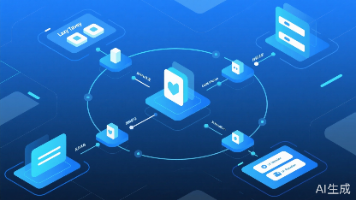






所有评论(0)